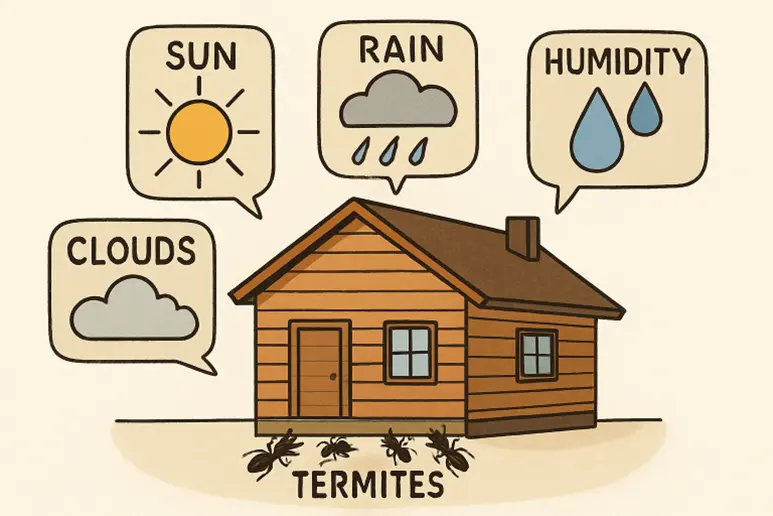Weather changes significantly impact termite behavior and spread, making seasonal and climate changes a significant factor in infestation risk. Temperature, humidity, and rainfall patterns influence termite breeding, nesting, and feeding habits, leading to increased activity during warmer, wetter periods. Climate change is causing termites to expand into new regions and become active at unexpected times. Understanding these environmental changes can help homeowners take preventive measures and protect structures from costly damage.
Termites, commonly referred to as “silent destroyers,” have a notorious reputation for their ability to inflict significant damage on wooden structures—often before their presence is even detected. Their behavior, including feeding patterns, reproduction, and colony expansion, is intricately influenced by prevailing weather conditions. For homeowners and pest control professionals, understanding these environmental influences is essential for prevention and formulating a response plan when infestations occur. When signs of termites appear, seeking reliable termite control in Tulsa can make all the difference in preserving home integrity and value. External factors like temperature, humidity, rainfall, and extreme weather can dramatically impact termite activity. Additionally, climate change is shifting the boundaries of termite-friendly habitats, exposing new areas to higher risks. By appreciating how these weather patterns interact with termite behavior, homeowners are empowered to act early and minimize structural damage.
Temperature Influence on Termite Activity
Termites, as cold-blooded or ectothermic insects, are highly susceptible to fluctuations in ambient temperature. When the environment warms, termite metabolism accelerates. This metabolic boost leads to higher feeding and reproduction rates, magnifying their potential for destruction. Scientific studies have revealed that a 10°C increase in temperature can cause termite-driven wood decay activity to intensify over sixfold, highlighting the vulnerability of wooden homes in warmer regions. During cool weather, termites become sluggish and may remain deeper underground or in sheltered nests to preserve warmth, lowering their visible activity but not eliminating their threat.
Humidity’s Impact on Termite Behavior
Humidity is another decisive factor in the comfort and survival of termite colonies. Termites require moist surroundings to avoid the fatal risks of desiccation. A humid environment supports the digestion of cellulose—the core nutrition termites extract from wood—and encourages the establishment and expansion of colonies. In regions with persistently high relative humidity, termite infestations tend to be more severe, lasting longer and spreading more widely. Keeping indoor environments dry and monitoring moisture levels around the foundation are key tactics for reducing termite risks.
Effect of Rainfall on Termite Infestations
Rainfall directly shapes the ease termites can access food and establish new colonies. After heavy rains, the ground remains damp, softening soils and making it easier for subterranean termites to move and construct mud tubes up foundation walls and wooden structures. This moist earth provides both travel corridors and protective shelter from predators and the elements. Conversely, flooding caused by excessive rainfall can disrupt termite nests and kill large portions of the colony. However, these events may also force surviving termites to seek refuge in new locations—sometimes your home.
Climate Change and Termite Distribution
Climate change’s advancing effects are redrawing the termite habitats map across North America and globally. Elevated average temperatures and altered rain patterns create favorable conditions for termites in areas previously shielded by climate limitations. Some traditionally colder regions are now experiencing increased termite activity as winters become milder. This expansion raises risks for homeowners and challenges pest control professionals to adapt their strategies for different environments. As termite populations spread into new territories, local building materials and construction practices may be more vulnerable due to a lack of historical exposure. Pest management plans must now account for shifting climate trends and emerging infestation zones. Increased awareness and updated building codes may help mitigate future structural damage. Homeowners in at-risk areas should consider regular termite inspections, even if infestations were previously uncommon. Proactive prevention is key as termite behavior adapts to our changing climate.
Extreme Weather Events and Termite Behavior
Severe weather events, such as hurricanes, tornadoes, and floods, have a mixed impact on local termite populations. Destructive storms may physically displace or drown established colonies. Nevertheless, these events often lead to scattered debris, softened wood, and new sources of moisture—all prime conditions for a surge in future termite numbers. Additionally, damaged structures provide easy access points and untreated wood, making them attractive targets for opportunistic colonies. Transporting infested materials during cleanup operations can also spread termites to uninfested areas.
Preventive Measures Against Termite Infestations
The link between weather and termite activity should prompt homeowners and property managers to take proactive measures. Regular inspections should be scheduled, with professional pest control companies performing annual or biannual checks for early signs of termite activity. Moisture control should be addressed, with proper drainage, dry foundation area, and crawl spaces. Wood should be stored away from the structure, treated with preservatives or sealants, and landscaped with an 18-inch gap between soil and wooden elements. Property owners can significantly reduce the risk of costly termite infestations by staying alert to weather changes and implementing preventive strategies.
Also Read-Life Events and Real Estate: Factors Leading to Selling Your Home for Cash


